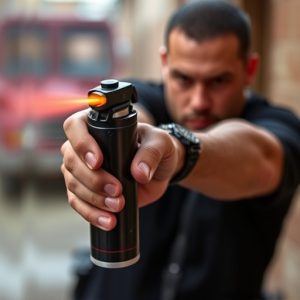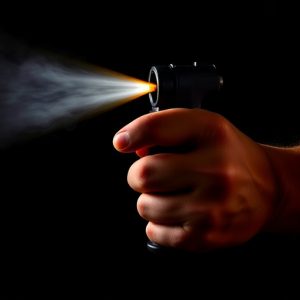How to Treat and Prevent Pepper Spray Exposure: A Comprehensive Guide
TL;DR: Understanding pepper spray exposure involves recognizing its causes (capsaicin irritation) an…….
TL;DR: Understanding pepper spray exposure involves recognizing its causes (capsaicin irritation) and symptoms (eye, nose, mouth discomfort, respiratory distress). Immediate treatment includes moving to a well-ventilated area, flushing eyes with water for 15 minutes, using a mask or damp cloth for breathing issues, and cleaning skin gently. Seek medical attention for persistent or severe symptoms. Prevention strategies focus on protective gear, clear surroundings, staying informed about local laws, and understanding the spray's range (2-3 meters). For self-defense, know pepper spray's legality varies; treat exposure by moving to safety, removing contaminated clothing, rinsing eyes, and seeking medical help for worsening respiratory distress.
“Discover the power of civilian-grade pepper defense spray and how it can be both a protective tool and a cause for concern. This comprehensive guide delves into the intricacies of understanding pepper spray exposure, its symptoms, and effective treatment methods. Learn practical steps to manage and treat exposure, ensuring you’re prepared with knowledge on preventing irritation. Explore legal considerations regarding self-defense and gain insights into staying safe while navigating potential risks. For a detailed look at How to Treat Pepper Spray Exposure, read on.”
- Understanding Pepper Spray Exposure: Causes and Symptoms
- Step-by-Step Guide to Treating Pepper Spray Exposure
- Preventive Measures: How to Avoid Pepper Spray Irritation
- Legal Considerations: Using Pepper Spray for Self-Defense
Understanding Pepper Spray Exposure: Causes and Symptoms
Pepper spray exposure can occur in various situations, from self-defense to accidental discharge. Understanding what causes it and recognizing its symptoms is crucial for knowing how to treat pepper spray exposure effectively. When exposed to pepper spray, an individual inhales capsaicin, the active ingredient responsible for the burning sensation. This irritant gets into the eyes, nose, mouth, and respiratory system, leading to discomfort, tearing, coughing, difficulty breathing, and a strong, unpleasant odor.
To treat pepper spray exposure, one should immediately move to an area with fresh air, preferably indoors or under shade, to avoid further inhalation of the irritant. In case the eyes are affected, flush them gently with clean water for at least 15 minutes, ensuring no residual spray remains. If breathing is challenging due to coughing or congestion, use a face mask or cover your nose and mouth with a cloth dampened with clean water. Seek medical attention if symptoms persist or worsen, especially in children, elderly individuals, or those with pre-existing respiratory conditions.
Step-by-Step Guide to Treating Pepper Spray Exposure
How to Treat Pepper Spray Exposure
If you’ve been exposed to pepper spray, whether during a protest or an accidental encounter, immediate and proper treatment is crucial. Start by removing any clothing that came into direct contact with the spray, washing your eyes thoroughly with clean water for at least 15 minutes. This helps flush out residual chemicals. If breathing becomes difficult, move to a place with fresh air and try to calm down; hyperventilating can worsen symptoms.
For skin irritation, gently wash the affected areas with mild soap and cool water. Avoid using harsh cleansers or rubbing the skin vigorously. Apply a cold compress or ice pack wrapped in a towel to reduce swelling and pain. If necessary, take an over-the-counter antihistamine or pain reliever for discomfort. It’s important to stay hydrated by drinking plenty of water; pepper spray can cause dehydration and further irritation. Seek medical attention if symptoms persist or worsen, especially for eye irritations that don’t resolve after thorough flushing.
Preventive Measures: How to Avoid Pepper Spray Irritation
Preventive Measures: Avoiding Pepper Spray Irritation
Before discussing how to treat pepper spray exposure, it’s equally important to explore ways to avoid it altogether. Understanding and implementing preventive measures can significantly reduce your risk of experiencing painful irritation from civilian-grade pepper defense spray. One key strategy is to familiarize yourself with the range and effectiveness of such sprays; knowing their typical reach and duration allows you to maintain a safe distance, typically around 2-3 meters (6-10 feet), depending on the product. Additionally, wearing protective gear like gloves, eye protection, and thick clothing can act as a barrier against direct contact and inhalation.
Regularly maintaining your surroundings by clearing debris and potential hiding spots for spray canisters ensures that you’re less likely to encounter them unexpectedly. Being cautious in crowded areas or during demonstrations where pepper spray might be used also significantly lowers the risk of exposure. Always stay informed about local laws and regulations regarding the use of such defensive tools, as this knowledge empowers you to make smarter decisions for your safety.
Legal Considerations: Using Pepper Spray for Self-Defense
When considering civilian-grade pepper defense spray for self-defense, it’s crucial to understand the legal implications and responsibilities that come with its use. The legality of carrying and using pepper spray varies significantly by jurisdiction. In many places, it is permitted for personal protection, but strict regulations govern its sale and possession. For instance, some regions mandate a permit or registration for pepper spray ownership, while others have age restrictions. It’s essential to research and comply with local laws to avoid legal repercussions.
If you do find yourself exposed to pepper spray during an altercation, knowing how to treat the effects is vital. Inhaling pepper spray can cause severe irritation and temporary blindness. How to Treat Pepper Spray Exposure includes moving to a safe location away from the source, removing any clothing or accessories that may trap the chemical, and rinsing eyes thoroughly with clean water for at least 15 minutes. Seeking medical attention is recommended if symptoms persist or worsen, as pepper spray exposure can lead to respiratory distress, especially in those with pre-existing conditions.
Pepper spray, while a powerful tool for self-defense, can cause significant discomfort and even long-term irritation if not used properly. Understanding exposure causes and symptoms is crucial, as is knowing how to treat pepper spray exposure effectively. By following the step-by-step treatment guide and implementing preventive measures, you can minimize the impact of pepper spray and stay safe. Remember, it’s essential to balance self-defense with legal considerations, ensuring your actions are within the law. With proper knowledge and preparation, you can protect yourself and your loved ones in various situations.


